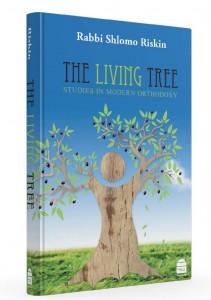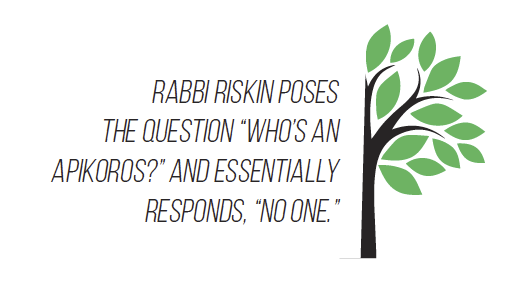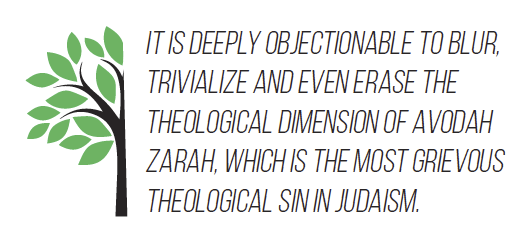Review Essay The Living Tree: Studies in Modern Orthodoxy
 By Rabbi Shlomo Riskin
By Rabbi Shlomo Riskin
Maggid Books
New Milford, Connecticut & Jerusalem
2014 ~ 384 pages
Reviewed by David Berger
Rabbi Shlomo Riskin has a remarkable record of achievement. His ability to inspire and to evoke the deepest emotions combined with an acute intellect, organizational talent and creative vision have made him a unique, even historic figure.
Two of his recent books embody different elements of this constellation of qualities. Listening to God presents occasionally embellished accounts of his experiences through the years and is often moving to a degree that cannot readily be captured in words. I feel a special sense of gratitude for this work. Four years ago, I was seriously ill for several months and had great difficulty concentrating. There were only two books that I found sufficiently engaging to overcome this debilitating state. One was Mevakshei Panecha, Rabbi Haim Sabato’s record of his conversations with Rabbi Aharon Lichtenstein, zt”l; the other was Listening to God.
The Living Tree reflects the intellectual and ideological dimension of Rabbi Riskin, and it demands more critical assessment. This is a collection of essays on a range of topics that embrace many of the quintessential concerns engaging Modern Orthodoxy: secular learning; dissent and pluralism in halachah; authority versus autonomy; approaches to Biblical personalities; heretics and heresy; women as halachic scholars and judges; agunot; the State of Israel and the process of Redemption; the Jewish mission to the world; Jewish-Christian interaction and dialogue. For no reason that I can fathom, the publisher fails to provide the dates and venues of any of these essays. This is no small impediment to gaining a picture of the development of the author’s thought, the currency of some of his positions, and the degree to which his arguments are original or derivative without engaging in a challenging and time-consuming research effort.
Needless to say, I cannot address the full range and richness of Rabbi Riskin’s discussions in this review. With respect to many of these issues, he presents a position characteristic of mainstream Modern Orthodoxy—or Orthodoxy tout court—with learning and clarity. In dealing with controversial matters, he often proffers arguments that reflect a command of the relevant texts and merit respect even from those who reject his position. Thus, the weight of halachic opinion militates against the appointment of women judges, but Rabbi Riskin, who directs a program that trains women for such positions, marshals the arguments for the minority view in a largely unexceptionable fashion. The wisdom of acting on this view is a separate and serious question.
The most radical element in that essay is an assertion—based on Rabbi Riskin’s understanding of a single sentence in Rabbi Manoach’s commentary to Maimonides’s code—that women today who do not bear exclusive responsibility for running their household are obligated to perform time-bound commandments (pp. 122-123). I would be very surprised if Rabbi Riskin really rules in accordance with this position, and if he does not, the presentation in the book cries out for qualification.
His proposal for a solution to the tragedy of the agunah displays considerable learning as well as reasoned arguments that deserve attention. Rabbi Riskin wrote an entire book setting forth and defending this proposal, which urges that rabbinic courts resort to the extreme option of annulling marriages (hafka’at kiddushin) in cases of prolonged, stubborn recalcitrance. He is well aware that even authorities who entertain this possibility in theory are unwilling to apply it except in the most dire circumstances such as “times of persecution and great slaughter” (p. 183, citing Rabbi Shlomo Zalman Auerbach). Rabbi Riskin maintains that the number of agunot has reached the point where we face an analogous emergency. For Rabbi Auerbach and all major decisors, many of whom reject this approach in principle, concern that the marital bond and its sanctity will be devalued by a policy of annulment requires maintaining a higher bar, and in this case Rabbi Riskin understands that he cannot act on his proposal.
In one instance, his zeal to help agunot leads him to make an argument that appears incoherent. He asserts that a growing number of Israeli couples, fearful of iggun, opt for marriage with halachically invalid ceremonies or with no ceremony at all, and this will “more likely lead to mamzerut and adultery than a rare hafka’at kiddushin” (p. 189). Since it is precisely a valid marriage that can later lead to those consequences, I am unable to make sense of this argument.
In some other areas where Rabbi Riskin advocates a liberal stance, he nonetheless tempers it with a conservative caveat. Thus, he is willing to go very far indeed in giving women positions of religious leadership, including the title of morat hora’ah, but he stops short of using the term rabbi because there are communities where rabbis are expected to lead services or read the Torah (p. 132). He permits an individual to modify the blessing “You have not made me a woman” in accordance with a formula that he proposes, but would not allow this in public prayer without the endorsement of leading halachic authorities (pp. 158-159). He endorses the value of dissent and pluralism in halachah but makes the extremely important point that “halakhic legitimacy can only be accorded to those who accept upon themselves the axioms upon which the halakhic system is based,” which he describes as “submission to a higher autonomous system” and acceptance of “an external and objective halakha.”
Let us now turn to three controversial issues with significant implications. In the last generation or two, the proper approach to the great figures in the Bible has triggered strong disagreements among Orthodox thinkers and educators both in Israel and the Diaspora. Should these figures be seen as virtually perfect or should imperfections be acknowledged? Rabbi Riskin vigorously argues for the second position, asserting that one should recognize the legitimacy of following peshat, which he calls “literal interpretation.” It is of considerable interest that he does not automatically choose interpretations critical of these heroes. Thus, in other essays, he regards Jacob and Rebecca’s deception of Isaac favorably, despite the fact that it is an almost paradigmatic example for those who maintain that peshat sometimes indicates that the Torah is critical of patriarchal behavior.
Nonetheless, he maintains a critical stance in several cases where the plain meaning of the text provides little support for his position or even militates against it. Thus, he defends the suggestion, which has become widespread in certain circles, that Abraham should have argued with God about the akeidah and hence failed the test (p. 97). He goes on to validate other readings as well, but insists that this one is entirely legitimate. It is telling that despite his placing the discussion within the context of literal interpretation, he does not even allude to the verse that makes this understanding problematic, to wit, the reward promised to Abraham “because you have obeyed Me.”
Similarly, he defends his proposal that Sarah left Abraham and went to Hebron, where she died, because she opposed her husband’s actions at the akeidah. This is based entirely on the premise that the Torah’s near-juxtaposition of Sarah’s death in Hebron to the akeidah means that it took place immediately thereafter, though even on this assumption we have nothing resembling actual evidence for Rabbi Riskin’s conjecture. This proposal, moreover, requires the affirmation—endorsed of course by a midrash—that Isaac was thirty-seven years old at the akeidah, which probably stands in tension with our instincts regarding peshat. My own view is that we must sometimes entertain the possibility, even likelihood, of moral failings by Biblical heroes, but this should not be our first or even our second instinct. We should endorse such a conclusion only if we believe that the plain meaning of the text strongly supports it. I cannot elaborate here, but too many Orthodox Jews have lost sight of this point.
In another essay (pp. 107-116), Rabbi Riskin poses the question “Who’s an Apikoros?” and essentially responds, “No one.” The argument is that it is wrong to identify anyone as an apikoros because it is difficult to define what that is. Maimonides himself was accused of heresy; the Talmud defines apikoros by actions like scorning a scholar, but not by the criterion of unacceptable beliefs; the Chazon Ish said that no one today should be subject to the treatment inflicted on a heretic; and contemporary theological deviationists are generally the product of their education and environment. It is also pragmatically self-defeating to condemn rather than build.
Much of this is, no doubt, correct, but some of it is misleading. The position that the category of apikoros should be defined by actions and not beliefs sidesteps the other categories listed in the relevant mishnah (which, to be sure, is quoted in full) that exclude one from the World to Come on the basis of beliefs. While there is much to be said for a tolerant attitude toward contemporary adherents of heretical beliefs, there is great danger in blurring or erasing the category of heresy itself. This essay does not quite do this, but it comes perilously close. The issue is of acute importance at this time, when we are witness to an assault on the position that beliefs matter at all1 and when adherents of positions that are heretical by any historic measure are welcomed, especially in the Dati Leumi community in Israel, as respected Orthodox figures. A religion, certainly an Orthodox version of a religion, requires boundaries.
Rabbi Riskin, like many Religious Zionists, attributes redemptive significance to the State of Israel, but he goes further than most. His very definition of Modern Orthodoxy includes our obligation “to initiate redemption” (p. xiii). The establishment of the State, he says, is a key step in a larger Jewish mission.
Immediately before turning to the obligation to “engage the world,” Rabbi Riskin argues that Israel must take an “inclusivist” position with respect to the conversion of people of Jewish descent who are not halachically Jewish (p. 213). Here the brief discussion is beset by considerable tension. The point of Rabbi Riskin’s proposal is unquestionably to facilitate the conversion of Israeli adults from the former Soviet Union who are not prepared to accept the yoke of the commandments without reservations. He maintains, explicitly drawing upon Rabbi Haim Amsalem’s Zera Yisrael, that they do not have to embrace the full gamut of observance. He goes on to say that their conversion requires emphasis on “Jewish values and traditions—Sabbath, festivals and kashrut—rather than details of our prayer ritual” (p. 213). The surprising contrast with prayer ritual can create the impression that their observance of the Sabbath and kashrut does have to meet Orthodox standards, but this cannot be what Rabbi Riskin means, for the manifest reason that the people he is targeting are unprepared to accept such an obligation. He undoubtedly requires a lesser level of observance, but he is hesitant to say this with full clarity. Moreover, his appeal in this context to Rabbi Joseph Ber Soloveitchik’s covenantal categories of fate and destiny, which these converts join by their willingness to live in Israel and serve in the IDF, ignores compelling evidence that Rabbi Soloveitchik would have rejected a lenient position on the convert’s acceptance of the commandments.2
As to the larger Jewish mission, Rabbi Riskin provides ambitious essays on attitudes toward Christianity and dialogue with Christians that are provocative and problematic. He asserts that avodah zarah has been and presumably should be defined in terms of the immoral behavior of ancient pagans, thus denuding the definition of theological content (p. 288). He maintains that all rabbinic authorities in medieval Ashkenaz as well as Rabbi Yosef Karo “considered Trinitarian Christianity to be illegitimate theology but ruled that Christians are not idolaters” (p. 307). “The overwhelming majority of Middle Age decisors . . . did not believe Christianity to be idolatry for the Christians” (p. 328). At the same time, without advocating a full missionary enterprise, he perceives an obligation to persuade receptive Christians to recognize the truth of the Jewish faith.
I have elsewhere indicated that I would very much like to embrace the possibility—suggested by Rabbi Isaac Herzog—that only the immoral paganism of old must be removed from the Land of Israel, and some aspects of the much-discussed, extremely liberal position of the Meiri (noted by Rabbi Riskin on p. 307) can and should be mobilized in governing our relationship to Christians and to non-Jews in general. Nonetheless, it is deeply objectionable to blur, trivialize and even erase the theological dimension of avodah zarah, which is the most grievous theological sin in Judaism. Medieval Jews did not give their lives to avoid an “illegitimate theology,” and it is not at all the case that the majority, let alone the overwhelming majority, of medieval decisors did not believe Christianity to be avodah zarah for (born) Christians, though many modern ones did take this position. From my perspective, Christianity can best be characterized as avodah zarah in a monotheistic mode, and it is of great importance to recognize that although it is indeed avodah zarah, certainly for Jews, there is a chasm separating it from paganism.3
Rabbi Riskin’s advocacy of theological interaction with Christians has led him to a re-evaluation of Rabbi Soloveitchik’s opposition to interfaith theological dialogue expressed in the celebrated essay “Confrontation” (pp. 313-339). Essentially, he argues that Rabbi Soloveitchik was opposed to theological dialogue only under conditions that no longer apply given the changed attitude toward Judaism among Catholics, evangelicals and many mainstream Protestants. I responded at length to the Hebrew version of this essay.4 In my view, Rabbi Riskin’s argument is based on a tendentious and indefensible reading of “Confrontation” and is refuted by a simple fact. Rabbi Soloveitchik provided guidance to the RCA and OU with respect to interfaith dialogue even after the bulk of the changes to which Rabbi Riskin refers had already taken place. This guidance decidedly followed the principles set forth in “Confrontation.”
I am not prepared to say that this ends the discussion. Rabbi Riskin is not precluded from maintaining that the acute challenges facing Israel require cultivating Christian supporters even through the means of theological interaction, but this argument should be made without turning Rabbi Soloveitchik into an unwilling ally.
Finally, I note briefly that a work devoted to Modern Orthodoxy should maintain standards of historical and linguistic scholarship that would pass muster in the academy. In too many instances, Rabbi Riskin makes assertions that do not come close to passing this test. Here is one example in each of these categories. 1) To resolve a difficulty in Maimonides’s code, he suggests that “those who lived in Israel in [Maimonides’s] day were all halakhic sages” (p. 241). 2) He suggests that the four-letter name of God (Y-H-V-H), ahavah (love), and the Aramaic hav (give), which in point of fact have three different roots, share the same basic meaning and are linguistically connected (p. 65). One should at least consult experts before committing such speculations to writing.
For all its drawbacks, this is a stimulating work on issues of great moment by an influential leader and thinker whose views deserve our sustained attention.
Notes
1. See Menachem Kellner, Must a Jew Believe Anything? (London and Portland, Oregon, 1999), soon to appear in Hebrew, and my review essay in Tradition 33:4 (1999): 81-89. Kellner responded to the review—in my opinion unpersuasively—in an afterword to the second edition (2006).
2. For Rabbi Soloveitchik’s powerful evocation of the commitment entailed by conversion, seeAl Ha-Teshuvah (Jerusalem, 1975), pp. 136-137.
3. I expressed the views noted in this paragraph in “Jews, Gentiles, and the Modern Egalitarian Ethos: Some Tentative Thoughts,” in the Orthodox Forum volume Formulating Responses in an Egalitarian Age, ed. by Marc Stern (Lanham, MD, 2005), pp. 83-108.
4. “Emunah bi-Reshut ha-Yahid,” Makor Rishon: Musaf Shabbat, Nov. 16, 2012. The easiest way to access this article is through a Hebrew Google search under emunah bi-reshut ha-yahid.
Dr. David Berger is dean and Ruth and I. Lewis Gordon professor of Jewish history at the Bernard Revel Graduate School of Jewish Studies of Yeshiva University.


